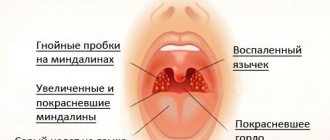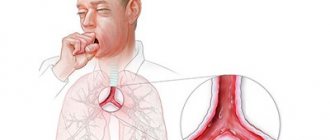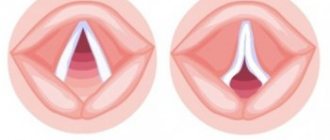Congenital stridor in an infant - whistling and noise when breathing
Often after the birth of a child or in the first or second months of life, the child whistles, sniffs, mutters or grumbles while breathing. This worries parents - we will try to understand the reasons for these phenomena.
The anatomy of the upper respiratory tract in infants, as well as other body systems, has certain characteristics.
Children's larynx has little free space, and the nasal passages are narrow and tender, with a small nose and air often cannot pass freely, and all the obstacles make the child grumble and murmur. Finally, the main mechanism for the development of various sounds or breath sounds is the creation of turbulent air currents after passing through the constricted larynx.
In most cases, the cause of grunting and sniffing noises during breathing is the development of crusts in the baby's nose, but another reason for all these noises in a child is also considered - congenital stridor.
Grunting and sleeping of a child can also be caused by congenital anomalies of the nasal passages or curvature of the nasal septum, the onset of rhinitis, congenital eustachitis or labyrinth.
In order to minimize the baby’s breathing difficulties, parents need to:
- humidify the air in the room using ventilation and carry out wet cleaning in the children's room at least 1-2 times a day;
- clean the baby’s nose daily with cotton swabs;
- If necessary, if nasal breathing is very difficult, wash your nose with saline solution.
If your child's nose is blocked frequently and for a long time, you should contact your pediatrician to find out the cause.
What is congenital stridor
- Congenital stridor, or noisy and rough breathing, occurs immediately after the baby is born, but sometimes this congenital abnormality can occur later.
- The sounds of a child's breathing may vary in character and timbre.
- The sound of the murmur depends on the original cause of the stridor - usually it is a congenital feature associated with soft laryngeal cartilage when the nasal passages are too narrow, which is congenital stridor.
But it could also be congenital stridor:
- vocal fold paralysis;
- benign neoplasms of the larynx;
- laryngeal papillomatosis;
- laryngeal cysts;
- Choan artesia;
- partial laryngeal paralysis;
- struma congenita, often associated with hypothyroidism
The pathology is recognized and corrected by an otolaryngologist, neurologist, pediatrician, gastroenterologist and pulmonologist.
- It is important to note that abnormal sound levels may vary depending on the situation.
- When you sleep in a warm, moderately humid room while walking, your breathing can be almost silent.
- Conversely, increased noise is noticeable during crying, coughing, sucking and swallowing.
Most often, there is no neonatal period. However, children under one year of age may be underweight and therefore have poor development, swallowing problems, and voice changes.
It should be noted, however, that stridor in children is often mild and does not affect the child’s development, nutrition and sleep.
Particular attention should be paid to infants when they become infected. Catarrhal symptoms that appear during the disease provoke an acute attack of stridor. The baby's condition worsens greatly, shortness of breath develops, the skin turns blue when breathing, and at the height of breathing there is an attraction of the elastic parts of the chest (intercostal spaces, jugular fossa, epigastric region).
Severe disease can lead to suffocation, which is life-threatening, often leads to detailed results and requires immediate medical attention and hospital stay in a children's clinic.
As the child matures, the cartilage hardens and the cavity expands, the pathology begins to disappear and the child is no longer bothered.
If the symptoms of the pathology have not subsided by the 6th month of the child’s life and have not disappeared completely by the age of 2, a comprehensive examination is prescribed to identify the organic causes of noisy breathing.
Congenital stridor
Congenital stridor is abnormally loud (wheezing or hissing) breathing caused by an abnormality of the congenital larynx or trachea. Congenital stridor manifests as loud difficulty breathing that is worsened by crying and coughing. The diagnosis of congenital stridor is made by a pediatrician, otolaryngologist and pulmologist taking into account the patient’s medical history, laryngoscopy, tracheobronchoscopy, esophagoscopy. Treatment of congenital stridor for functional reasons is not required: with the growth of the head of the cartilage (for 2-3 years), stridoric breathing disappears. If the pathology is caused by organic causes, surgical intervention may be required.
Congenital stridor is a baby's disease that must be treated by specialists in the field of pediatrics, otorhinolaryngology and pulmonology. Congenital stridor usually appears at birth and rarely occurs in the first month of a child's life or later.
A characteristic feature of stridor is pathologically noisy breathing, which is associated with overcoming the resistance that arises in the path of air masses as they pass through the narrowed section of the larynx.
Congenital stridor is not an independent nosological form, but indicates respiratory obstruction caused by various pathological conditions of the larynx and trachea.
From 60 to 70% of cases of congenital stridor in children are caused by abnormal development of the larynx and upper respiratory tract. Most often, stridor breathing is caused by a congenital weakness of the outer ring of the larynx (laryngomalacia).
In this case, the epiglottis and brupal epiglottis fold enter the laryngeal cavity during inhalation, which is accompanied by its obstruction and the noise of stricture during inhalation. Laryngomalacia is often observed in premature infants suffering from malnutrition, rickets and spasmophilia.
In some cases, congenital laryngeal weakness may be combined with other breathing defects such as tracheomalacia and tracheobronchomalacia.
These diseases are associated with a local form of muscle hypotension caused by delayed development of the neuromuscular system. Children with congenital stridor and neuromuscular insufficiency may also exhibit gastroesophageal reflux, cardiagalasia, sleep apnea, and eyelid ptosis.
Therapy for pathology
When treating stridor, the age of the patient is taken into account. Also, the main therapy is aimed at eliminating the disease that provoked the pathology. Given the high risk of developing respiratory failure, patients require emergency care.
Treatment in adults
Laryngeal stridor in adults is treated symptomatically. If edema develops, patients are prescribed decongestants. If the patient experiences respiratory failure, then he is shown a mixture based on oxygen and helium. It is universal for both laryngeal edema, croup, and cancer.
As a decongestant, a 2.25% solution based on racemic adrenaline mixed with 3 ml of saline is prescribed. Therapy is carried out using a nebulizer. Additionally, the patient is given intravenous dexamethasone in an amount of 10 mg. Subsequently, the dose of the drug is reduced to 4 mg and administered once every 6 hours.
If stridor occurs due to cancer, the following measures are taken:
- use of oxygen inhalation;
- administration of glucocorticoids intravenously;
- carrying out radiation therapy;
- undergoing chemotherapy;
- performing surgical resection;
- Prescription of laser cytoreduction for large laryngeal tumors.
Peculiarity. As signs of respiratory failure progress, patients undergo tracheal intubation by inserting an endotracheal tube into it. If there is no effect from this method of therapy, tracheostomy is prescribed.
Therapy in children and infants
If severe symptoms are observed, then treatment of stridor in infants is carried out only in a hospital setting. During attacks, children are given hormonal drugs, adrenaline inhalations, and bronchodilators are prescribed. In critical cases, tracheostomy is performed, as well as intubation with artificial ventilation.
If a baby has an anomaly in the larynx, then he undergoes laser surgery by making incisions in the area of the epiglottis. Also, the aryepiglottic folds can be dissected. If necessary, the child's arytenoid cartilages are completely excised.
If a child has a tumor in the larynx, surgery is performed using an endoscope. If a baby has congenital hypothyroidism, he is prescribed hormone replacement therapy.
Important! Congenital stridor in a compensated form can completely disappear in a child by 2 or 3 years of age. In such cases, no treatment is carried out, but the child should be under the supervision of an otolaryngologist.
Stridor breathing in children: provoking factors, symptoms, 2 treatment methods
Stridor is not an independent disease, but is considered a symptom of any disease that manifests itself in the form of respiratory stenosis.
This question is often asked by parents. Because before treatment, it is always important to determine the underlying cause of the pathological symptom.
Predisposing features of the respiratory tract in children
Of course, strichotic breathing is more often observed in young children. This is due to the fact that the anatomy of the upper respiratory tract is imperfect and there are some peculiarities. The larynx in children has a small opening. And finally, the main mechanism for the development of strikorotic breathing is the creation of turbulent air flows after passing through the narrowed lumen of the larynx.
But it is important to note that not all children have pathological stridor. The situation is aggravated by abnormalities of the upper respiratory tract. In case of weakness of the cartilaginous elements of the larynx, sagging of such cartilages can lead to mechanical blockage and the appearance of a strict respiratory system. This pathology is observed in premature babies with rickets.
As already mentioned, stridor is a manifestation of a particular disease. The cause of pathological breathing sounds can be congenital defects of the respiratory system, gastrointestinal tract and cardiovascular system.
Stridor often develops during acute infectious diseases and dies after complete recovery. Allergic reactions, accompanied by swelling of the larynx, can also occur during strict breathing.
Benign and malignant neoplasms of the larynx are more common in adults than the causative factor of stridor. Pathological symptoms may result from traumatic injury to the larynx or aspiration of a foreign body. But compression of the larynx from the outside is also possible, i.e. tumor of the esophagus or inflammation of the thyroid tissue.
Congenital stridor
Congenital stridor occurs immediately after birth. The main manifestation is noisy, rough breathing. Congenital pathology can also occur later, but is rare. The mechanism of pathological noise is the same and indicates the occurrence of turbulence in the air flow through a narrow larynx.
Causes of congenital stridor
The main cause of congenital stridor is abnormal development of the larynx. In premature babies, the cartilage-covered larynx, trachea and bronchi soften. Such defects of the respiratory tract form mechanical barriers to the passage of air.
Diagnostic methods
It is important for a child who exhibits these symptoms to be seen by doctors as soon as possible. The baby is examined by several specialists: a pediatrician, a cardiologist, an otolaryngologist and a pulmonologist.
During the inspection, the following must be recorded:
- respiratory rate (number of inhalations and exhalations);
- heart rate;
- skin color;
- muscle work during breathing (specify which muscles are involved).
Of course, microlaryngoscopy is prescribed, which makes it possible to identify or refute pathologies of the larynx.
One of the diagnostic methods is the breathing and heartbeat of a small patient examined by a doctor.
Modern diagnostic equipment is used to clarify the diagnosis.
. Be sure to take blood and urine for a thorough analysis.
If all these studies do not reveal pathological processes, then the child is prescribed tomography, MRI, and neurosonography. Especially if the cause of stridor is nervous disorders.
The baby can also be examined by an endocrinologist, who prescribes an ultrasound of the thyroid gland and hormone tests.
Stridor in newborns (congenital) - symptoms of pathological noisy breathing in children under one year old
Sometimes the long-awaited birth of a child is overshadowed by a terrible diagnosis - congenital stridor, which sounds from the mouth of a neonatologist in the maternity hospital. Every mother worries about her child, especially in matters of health. Is Strydor really a terrible thing, or should parents calm down and just follow the doctor's advice?
In most cases, stridor is simply the baby's loud breathing and does not pose a health risk.
Stridor in babies - what is it?
In newborns, stridor manifests itself as loud breathing, hissing, or whistling. Sometimes symptoms occur in babies in the first two months of life, and parents urgently need to take their baby to the doctor, as stridor can be a sign of a serious illness and life-threatening.
Striding breathing in newborns: causes and treatment - updated 03.19
For every mother, the birth of a long-awaited child is an unforgettable event in life. However, the joy of the birth of a child can be overshadowed by such a diagnosis from doctors as congenital stridor - a respiratory pathology that arises due to the tissue structure of the trachea and larynx and which, from the first days of life, manifests itself in the form of characteristic noises, wheezing and whistling during the child’s normal breathing.
There are two types of pathology:
- congenital stridor - occurs immediately after the birth of a child;
- and acquired - occurs a few weeks after birth and usually disappears on its own for a period of one to three years, as soon as the respiratory organs are fully developed and the cartilage tissue is consolidated.
In the first case, the situation looks much more serious, since abnormal sounds during normal breathing of a newborn baby are considered a serious anomaly that requires careful diagnosis and timely treatment.
Stridor in children: stages of the disease
According to medical statistics, congenital stridor occurs in almost every second newborn. There are four main stages in the development of respiratory pathology.
- With the development of compensated stridor in the first phase, the symptoms of pathology are very difficult to track, since all signs of pathology appear within several hours after the first manifestations.
- At the second stage - with compensation of boundaries - the situation is somewhat different: signs of stridor disappear only after a few days - abnormal noises and whistling during breathing remain for a long time. To accurately diagnose the causes of abnormal breathing, it is necessary to make a diagnosis and prescribe appropriate treatment.
- At the third stage of the disease - decompensated stridor, abnormal noises, whistling and loud breathing of the newborn are very noticeable. At this stage of pathology development, it is necessary for a doctor to monitor the child’s condition.
- The fourth is the most severe stage of the disease. During the development of the pathology, the newborn comes out of milk, he becomes very nervous and sad, he is filled with so many tears and screams that he may be unable to take another breath. This, in turn, has very serious consequences for the child’s life, so that when the fourth stage of the disease is detected, the child inevitably ends up in the hospital and is constantly under the strict supervision of doctors. To eliminate the consequences of pathology, doctors in most cases are forced to resort to surgery.
As for treatment, it is usually prescribed only after the onset of the third stage of the disease. In the first stages, no medications are required. This is because stridor usually goes away on its own within one to two years after the baby is born and before the respiratory system has fully developed.
Classification according to the degree of breathing impairment and symptoms
Depending on the development of the pathology, doctors distinguish 4 degrees of congenital stridor:
- I degree - does not require treatment;
- II degree - requires dynamic observation and, possibly, treatment;
- III degree - requires treatment;
- VI degree - requires immediate surgical intervention, as it is incompatible with life.
Important! In adults, the development of stridor is possible as a result of injuries to the respiratory tract, or foreign bodies entering the bronchi or lungs. The disease can develop in acute and chronic forms.
In addition, congenital disease differs by type:
- Inspiratory stridor - characterized by low noises that appear when inhaling. Mostly, damage to the respiratory tract is localized in the laryngopharynx area.
- Expiratory stridor - develops during exhalation and is manifested by medium stridor sounds. The obstruction is located below the vocal cords.
- Biphasic stridor - accompanied by very high-pitched noises. The affected areas are usually located at the level of the vocal cords.
The main symptoms of congenital stridor in infants are a ringing noise and whistle that occurs during inhalation or exhalation.
Its intensity, as a rule, increases when the baby lies on his back, screams, cries, or is very excited. There are often cases when during sleep the signs of the disease completely disappear, and during the period of activity of the child they reappear. At the same time, he has a satisfactory general condition and a clear, ringing voice. Important! Noncongenital forms of childhood stridor decrease by six months, and by the age of 3 they disappear completely.











